The automotive landscape is rapidly evolving, with electric vehicles gaining traction alongside traditional combustion engine offerings. In this comparison, we will delve into the Ford Kuga and Tesla Model Y, two popular SUV options that cater to distinct preferences and drive characteristics. As we explore their technical specifications and innovations, we aim to shed light on each model's advantages and drawbacks.
Ford Kuga vs Tesla Model Y - Differences and prices compared
Pricing and Variants
The Ford Kuga ranges in pricing from €39,950 to €52,200, catering to a diverse customer base with its compilation of petrol, hybrid, and plug-in hybrid variants. The Kuga’s price points make it an attractive option for buyers looking for flexibility in powertrains.
On the other hand, the Tesla Model Y commands a higher starting price, commencing at €44,990 and peaking at €59,990. Despite the higher price, Tesla's offerings lean exclusively into the electric vehicle market, showcasing a commitment to sustainable transport.
Powertrains and Performance
Ford offers the Kuga with multiple engine options, including petrol engines and hybrid configurations. The most powerful variant generates 243 HP, delivering robust performance with an acceleration from 0 to 100 km/h in 7.3 seconds. The Kuga's fuel consumption ranges from 5.3 to 6.4 L/100km, depending on the engine variant, making it a feasible option for those who may rely on traditional fuel sources.
In striking contrast, the Tesla Model Y features an all-electric powertrain, offering a choice of rear-wheel and all-wheel drive configurations. The Model Y’s power output can reach up to 534 HP, propelling it from 0 to 100 km/h in a scintillating 3.7 seconds for the Performance variant. Its efficiency is further highlighted by an impressive consumption rate of around 14.9 to 17.3 kWh/100km.
Battery Capacity and Electric Range
The Ford Kuga showcases hybrid technology with a relatively modest electric range of 69 km for its plug-in variant. The Kuga's battery capacity is limited to 1.1 kWh for the PHEV, which may not be sufficient for users who consider all-electric driving a necessity.
Conversely, the Model Y eclipses this with a battery capacity of up to 79 kWh and an impressive electrical range between 455 km to 600 km depending on the chosen variant. This significant range offers Model Y owners the confidence to undertake longer journeys with fewer refuels compared to their Kuga counterparts.
Interior and Trunk Capacity
Both the Ford Kuga and Tesla Model Y are designed to accommodate five passengers comfortably. The Kuga features a practical trunk capacity of 412 liters, which is practical for everyday use and families. However, it does not adopt a third-row seating option.
In comparison, the Tesla Model Y accommodates both five and optional seven passengers and provides a striking trunk capacity of 854 liters. This provides additional utility for families or those needing more cargo space, making it an attractive vehicle for both commuting and adventure.
Technology and Innovations
The Ford Kuga includes a suite of technological features, including Ford’s SYNC infotainment system, which integrates with smartphones and provides navigation, Bluetooth connectivity, and other modern features. Standard and advanced safety features are notable in the Kuga, making it a family-friendly choice.
The Tesla Model Y stands at the forefront of automotive technology with its intuitive “Autopilot” feature, a semi-autonomous driving system that is regularly upgraded via over-the-air software updates. Its minimalist interior design centers around a large touchscreen, controlling nearly all functions of the vehicle and providing a futuristic driving experience.
Conclusion
In summation, the Ford Kuga presents a versatile and practical option for buyers seeking a traditional SUV experience with flexible powertrain choices. Its focus on hybrid technology caters to users who may still wish to use conventional fuel. On the other hand, the Tesla Model Y is a powerhouse of innovation and efficiency in the all-electric segment, prioritizing sustainability without sacrificing performance.
Your decision will ultimately hinge on your unique needs: convenient traditional powertrains or cutting-edge electric efficiency. Whether you choose the Kuga or the Model Y, both vehicles offer compelling arguments in today’s automotive marketplace.
Here’s where it gets real: The technical differences in detail
Costs and Efficiency:
When it comes to price and running costs, the biggest differences usually appear. This is often where you see which car fits your budget better in the long run.
Ford Kuga has a slight advantage in terms of price – it starts at 34200 £, while the Tesla Model Y costs 34300 £. That’s a price difference of around 35 £.
As for range, the Tesla Model Y performs clearly better – achieving up to 622 km, about 554 km more than the Ford Kuga.
Engine and Performance:
Under the bonnet, it becomes clear which model is tuned for sportiness and which one takes the lead when you hit the accelerator.
When it comes to engine power, the Tesla Model Y has a decisively edge – offering 627 HP compared to 243 HP. That’s roughly 384 HP more horsepower.
In acceleration from 0 to 100 km/h, the Tesla Model Y is decisively quicker – completing the sprint in 3.50 s, while the Ford Kuga takes 7.30 s. That’s about 3.80 s faster.
In terms of top speed, the Tesla Model Y performs a bit better – reaching 250 km/h, while the Ford Kuga tops out at 200 km/h. The difference is around 50 km/h.
There’s also a difference in torque: Tesla Model Y pulls convincingly stronger with 493 Nm compared to 240 Nm. That’s about 253 Nm difference.
Space and Everyday Use:
Cabin size, boot volume and payload all play a role in everyday practicality. Here, comfort and flexibility make the difference.
Seats: offers more seating capacity – vs .
In curb weight, Ford Kuga is clearly perceptible lighter – 1526 kg compared to 1976 kg. The difference is around 450 kg.
In terms of boot space, the Tesla Model Y offers clearly more room – 822 L compared to 412 L. That’s a difference of about 410 L.
In maximum load capacity, the Tesla Model Y performs clearly perceptible better – up to 2138 L, which is about 604 L more than the Ford Kuga.
When it comes to payload, Ford Kuga slightly takes the win – 550 kg compared to 472 kg. That’s a difference of about 78 kg.
Who comes out on top?
Overall, the Tesla Model Y shows itself to be leaves the rival little chance and secures the title of DriveDuel Champion.
It convinces with the more balanced overall package and proves to be the more versatile choice for everyday use.
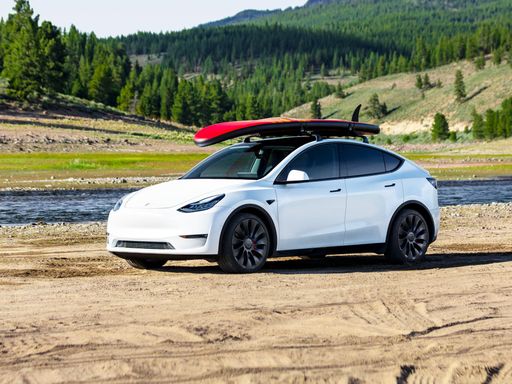 @ Tesla, Inc.
@ Tesla, Inc.
Tesla Model Y
Costs and Consumption
View detailed analysis
Engine and Performance
View detailed analysis
Dimensions and Body
View detailed analysis
Ford Kuga
The Kuga is Ford’s adaptable family SUV that blends usable space with a surprisingly lively driving character, making daily commutes and weekend escapes equally enjoyable. With smart interior packaging, an easy-to-use infotainment setup and composed road manners, it’s a sensible choice for buyers who want a bit of fun without the fuss.
details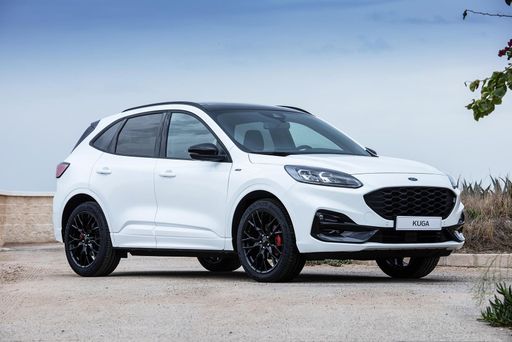 @ Ford Motor Company / Ford Media Center
@ Ford Motor Company / Ford Media Center
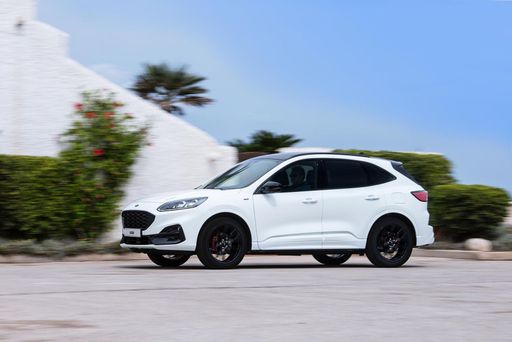 @ Ford Motor Company / Ford Media Center
@ Ford Motor Company / Ford Media Center
 @ Ford Motor Company / Ford Media Center
@ Ford Motor Company / Ford Media Center
Tesla Model Y
The Tesla Model Y blends SUV practicality with sports-car poke, wrapping a roomy, minimalist cabin and handy hatch into a slick, aerodynamic package that feels more Silicon Valley gadget than garage ornament. It’s an ideal pick for buyers who want effortless electric driving, regular software improvements and access to Tesla’s convenient charging network, though style-conscious shoppers should know it’s more about tech and efficiency than classic luxury.
details @ Tesla, Inc.
@ Tesla, Inc.
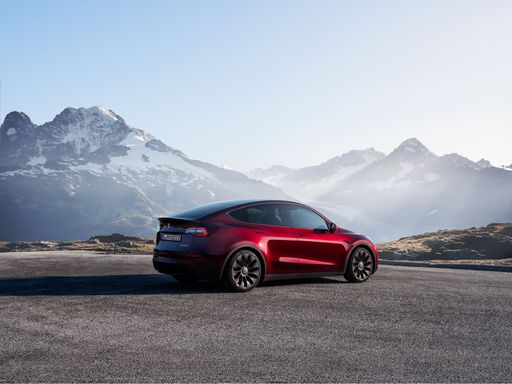 @ Tesla, Inc.
@ Tesla, Inc.
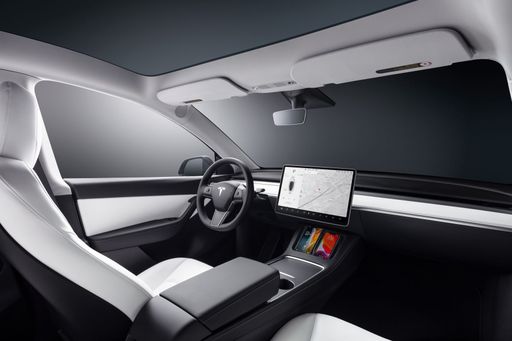 @ Tesla, Inc.
@ Tesla, Inc.
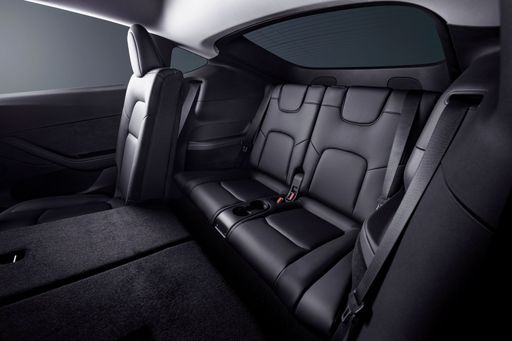 @ Tesla, Inc.
@ Tesla, Inc.
 @ Ford Motor Company / Ford Media Center
@ Ford Motor Company / Ford Media Center
|
 @ Tesla, Inc.
@ Tesla, Inc.
|
|
|
|
Costs and Consumption |
|
|---|---|
|
Price
34200 - 46300 £
|
Price
34300 - 53100 £
|
|
Consumption L/100km
2.8 - 6.8 L
|
Consumption L/100km
-
|
|
Consumption kWh/100km
-
|
Consumption kWh/100km
13.1 - 16.2 kWh
|
|
Electric Range
68 km
|
Electric Range
534 - 622 km
|
|
Battery Capacity
1.1 - 14.4 kWh
|
Battery Capacity
64.5 - 85 kWh
|
|
co2
55 - 154 g/km
|
co2
0 g/km
|
|
Fuel tank capacity
42 - 54 L
|
Fuel tank capacity
-
|
Dimensions and Body |
|
|---|---|
|
Body Type
SUV
|
Body Type
SUV
|
|
Seats
5
|
Seats
5
|
|
Doors
5
|
Doors
5
|
|
Curb weight
1526 - 1859 kg
|
Curb weight
1976 - 2108 kg
|
|
Trunk capacity
412 L
|
Trunk capacity
822 L
|
|
Length
4604 - 4645 mm
|
Length
4790 - 4797 mm
|
|
Width
1882 mm
|
Width
1921 mm
|
|
Height
1673 - 1681 mm
|
Height
1611 - 1624 mm
|
|
Max trunk capacity
1534 L
|
Max trunk capacity
2022 - 2138 L
|
|
Payload
541 - 550 kg
|
Payload
440 - 472 kg
|
Engine and Performance |
|
|---|---|
|
Engine Type
Petrol, Full Hybrid, Plugin Hybrid
|
Engine Type
Electric
|
|
Transmission
Manuel, Automatic
|
Transmission
Automatic
|
|
Transmission Detail
Manual Gearbox, CVT, Automatic Gearbox
|
Transmission Detail
Reduction Gearbox
|
|
Drive Type
Front-Wheel Drive, All-Wheel Drive
|
Drive Type
All-Wheel Drive, Rear-Wheel Drive
|
|
Power HP
150 - 243 HP
|
Power HP
299 - 627 HP
|
|
Acceleration 0-100km/h
7.3 - 9.9 s
|
Acceleration 0-100km/h
3.5 - 7.2 s
|
|
Max Speed
195 - 200 km/h
|
Max Speed
201 - 250 km/h
|
|
Torque
240 Nm
|
Torque
420 - 493 Nm
|
|
Number of Cylinders
3 - 4
|
Number of Cylinders
-
|
|
Power kW
111 - 178 kW
|
Power kW
220 - 461 kW
|
|
Engine capacity
1496 - 2488 cm3
|
Engine capacity
-
|
General |
|
|---|---|
|
Model Year
2025
|
Model Year
2025
|
|
CO2 Efficiency Class
E, D, B
|
CO2 Efficiency Class
A
|
|
Brand
Ford
|
Brand
Tesla
|
What drivetrain options does the Ford Kuga have?
The Ford Kuga is available as Front-Wheel Drive or All-Wheel Drive.
The prices and data displayed are estimates based on German list prices and may vary by country. This information is not legally binding.
